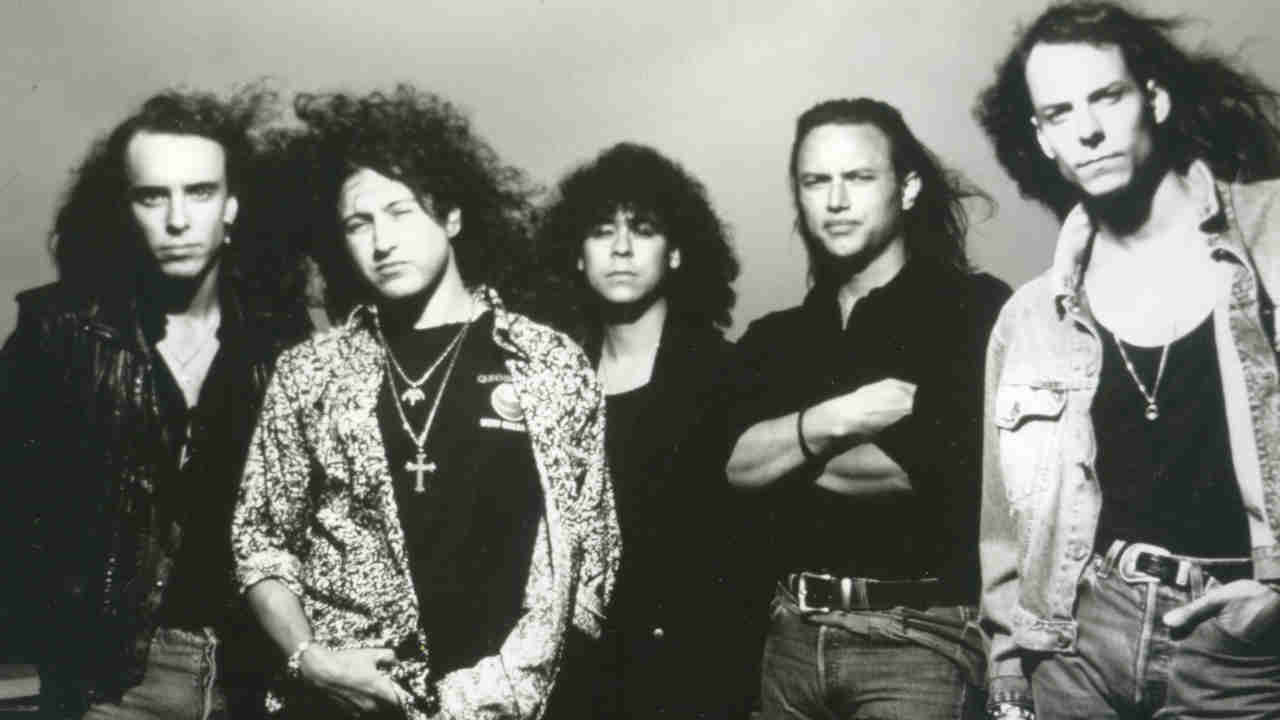“I’d be lying if I said there weren’t times when we thought: ‘Let’s just abandon the concept, and write some good songs’”: How Queensryche made conspiracy theory-based masterpiece Operation: Mindcrime,
Metal’s all-time greatest concept album? Operation: Mindcrime could be it

With its epic concept about junkie assassins, shadowy organisations and conspiracy theories, Queensryche’s third album, 1988’s Operation: Mindcrime, is one of the most acclaimed metal records of that decade. In 2005, original singer Geoff Tate and former guitarist Chris DeGarmo looked back on the making of a state-of-the-art prog metal classic.

It’s early 1988. A hotel in the centre of London, buzzing with rock’n’roll energy. The wintry windows are frosted. But the air is thickened by the glowing warmth of anticipation. In the subdued lighting of the empty bar sit two members of the most talked about band of the moment.
Queensrÿche vocalist Geoff Tate and guitarist Chris DeGarmo are in town, with a cassette of their new album, Operation: Mindcrime. The concept of a pre-release tape will seem antiquated today, but to those of us huddled in enthusiasm round the whirring machine, this was a taste of the future. And we were stunned.
“What do you think?” wondered Degarmo.
There was a collective sigh of awe. This was indeed the fulfilment of the enormous potential we’d heard when the band’s first demo came to light in 1983. Here were ‘The Thinking Man’s Metal Band’ giving the notion of the dreaded ‘concept album’ a swift and welcome tweak.
Of course, little did any of us in this privileged throng realise that we were hearing something that would become the standard by which so much has been judged in the decades since.

Queensrÿche had started out in 1981, formed by DeGarmo and fellow guitarist Michael Wilton in Seattle, Washington. They brought in former school friends Geoff Tate (vocals) and Eddie Jackson (bass), plus drummer Scott Rockenfield, and within two years had the aforementioned four-track demo recorded. It was heard by Kim and Diana Harris, who owned a local record store – called 206 – they took on the band for management.
Sign up below to get the latest from Metal Hammer, plus exclusive special offers, direct to your inbox!
The demo was eventually issued on their own 206 label, under the title Queen Of The Reich, selling an impressive 20,000 copies. Inevitably, this led to a bidding war between the major companies, one that saw the band succumbing to the charms of EMI-America.
Trading Judas Priest and Rush influences, with hints of Styx and Pink Floyd, the band’s first two albums – 1984’s The Warning and Rage For Order two years later – hinted at the vast reservoir of talent and ideas. But it was …Mindcrime that was to bring it all to the boil.

“In hindsight, I know a lot of people thought that our first two albums were just a prelude to Operation: Mindcrime,” says DeGarmo, “but we never saw it that way. I think people are more interested in seeing and hearing what a band can come up with that’s different, and not just hearing a rehash of the same old stuff. The last thing you need to hear is a band that are continually trying to copy themselves.
“As far as this album is concerned, we sat down and wrote a complete story. The music and the lyrics describe that story, and that’s something we’ve never done. When you listen to the album you’ll see that it’s not just the same old Queensrÿche. There is something different here.”
The band actually started work on the record in December 1986, while still touring on the back of Rage For Order.
“I can’t say that we immersed ourselves in the project at the time,” recalls DeGarmo. “All we had were a few riffs, and a few lines of lyrics. But when we got back home after the tour in February ‘87, things started to click.”
However, this was a very slow and laborious process. The songwriting process itself took eight months to get right, mainly because the band had to learn a new discipline. Operation: Mindcrime was a concept album, with a fully realised, conspiracy theory-themed story about a street junkie named Nikki who is recruited as an assassin by a shadowy organisation headed up by the mysterious Dr X – based in part on Geoff Tate’s experiences of mixing with members of a Quebec separatist movement while living in Montreal.
“When you write songs for a record, then what you’re looking to do is get together the best possible set you can,” explains Tate. “But this time we had to think in terms of a story, and how the lyrics and music held up in a wider context. That was a real challenge. You have that extra dimension to consider, and it was a while before we got that under control.”
“Did we ever think that this was too much like hard work?” DeGarmo remarked soon after the album was released. “I’d be lying if I said that there weren’t times when all of us thought that it was too tough. ‘Let’s just abandon the concept, and write some good songs’… yeah, we considered that. But the effort was worthwhile in the end, and we all feel better for having stuck it out.”
By October 1987, Queensrÿche were ready to record their new magnum opus.
“As always, we ended up having far more songs than we could use,” reveals DeGarmo on the volume of material. “But because Operation: Mindcrime has a concept, it wasn’t a case of having 20 songs ready and then picking the best 10. Each track is there for a specific reason. The only question we had was how far we wanted to take the story.”
One of the most crucial decisions to be made was who should produce this mega work. The man eventually given the task of fleshing out the band’s ideas was Peter Collins, who had a strong reputation from working with Gary Moore and Rush. But he wasn’t their original choice. They were after Neil Kernon, with whom they’d worked on Rage For Order. However, fate conspired to change plans.
“The deadline for starting the album was creeping closer and closer, and Neil still hadn’t finished working with Dokken,” explains DeGarmo. “We really had to get our shit together and find another producer as quickly as possible. Our management (QPrime) suggested we should try out Peter. We knew immediately that he was the right guy for the job.”
Collins himself fondly recalled the project several years after it was finished.
“I was used to working with musicians who had strong ideas, and also the budget to be ambitious, but this was a real departure for me. Working within a storyline made it feel like a musical, rather than an album. I’m not sure any of us at the time realised just what we were doing. But now, looking back, that’s one of the most satisfying moments of my career.”

It was typical of the band that they decided to cast some of the characters in the story rather than trying to do it all themselves. So veteran British actor Anthony Valentine was brought in to portray the villainous Doctor X, while Pamela Moore was given the not at all easy task of playing Sister Mary.
Moore was doing radio and TV commercials for a record store in Seattle, where she worked part time, when the call came to appear on …Mindcrime. DeGarmo phoned her up, asked if she’d like to audition – and within 24 hours Moore was in the studio.
“Geoff had already recorded his parts, so I did mine separately. In fact, I didn’t get the chance to sing with him until a couple of years later, when I toured with them,” she says.
Determined to get the album right, yet also mindful of the temptation to spend months and millions of dollars trying to get all the minutiae perfect, Queensrÿche decided the best course of action was to give themselves a strict time limit, which DeGarmo explained shortly after the album was released.
“Believe it or not, we work better to deadlines. So we gave ourselves three months to record the whole album. The tension and stress does help us to concentrate. In spite of it being the most difficult and challenging work we’ve ever done, it also has been the most fun.
“We managed to stick to every deadline we imposed during the production schedule, and we’re completely happy with the end result. I really feel that, even if we’d had more time, I doubt we could have ended up with anything better. It’s easy to fall into a kind of Def Leppard situation, where everything takes an eternity [Leppard at the time had just spent four years working on the Hysteria record]. Right at the beginning, I thought to myself that if we could finish with something like 85 per cent of what we wanted, then I’d be satisfied. We’ve managed to come up with an album that’s 100 per cent of what we wanted. You can’t believe how good that feels.”
Operation: Mindcrime, which was mostly recorded at Kajem/Victory Studios in Gladwyne, Pennsylvania, was mixed at Wisseloord Studios in Holland. It was released in May 1988, to an avalanche of critical praise. But commercially it wasn’t the immediate hit everyone associated with the band had been hoping for. It reached only number 58 in the UK charts and number 50 in America (Rage For Order had made it to number 47). But the passing of the years has given it a cachet that’s overshadowed everything else the band have done.
“I regard it as one more album in our development,” DeGarmo said in 1988. “Will it be an important record for us? Hopefully no more than anything else we’ll go on to do.”
But, within a couple of years, the strain of dealing with the growing success and impact of …Mindcrime was beginning to colour the band’s perspective.
“We’ve done our ‘concept album’, and don’t feel the need to repeat it,” Tate insisted, as the band’s next album, Empire, was issued in 1990. “Why should Operation: Mindcrime become a millstone around our neck? We’re all delighted it’s gotten such a good response, but it’s time for us to move on. The only influence it’s had on us this time is that we were all very conscious of the need to avoid going over old ground. Working on it was an amazing experience, but now we can get back to making records with strong songs and no storyline – that’s liberating.”
But, for all Tate’s protestations, Operation: Mindcime is now acknowledged as the most important album in the band’s history. Not the least by the members themselves. They’ve continuously performed the album onstage in its entirety, and released a sequel, Operation: Mindcrime 2, in 2006.
“Perhaps it will be the defining moment of all our careers,” DeGarmo admitted in the early 2000s. “But I never regret what we did. It’s a special album.”
Originally published in Metal Hammer issue 146, October 2005
Malcolm Dome had an illustrious and celebrated career which stretched back to working for Record Mirror magazine in the late 70s and Metal Fury in the early 80s before joining Kerrang! at its launch in 1981. His first book, Encyclopedia Metallica, published in 1981, may have been the inspiration for the name of a certain band formed that same year. Dome is also credited with inventing the term "thrash metal" while writing about the Anthrax song Metal Thrashing Mad in 1984. With the launch of Classic Rock magazine in 1998 he became involved with that title, sister magazine Metal Hammer, and was a contributor to Prog magazine since its inception in 2009. He died in 2021.



